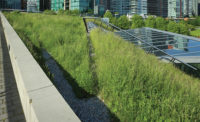Product Spotlight

Hunter Panels, Portland, Maine, offers one of the many products on the market to address these issues. Cool-Vent is a rigid roof insulation composed of a closed-cell polyisocyanurate foam core manufactured as a ventilated nailbase roof insulation panel. The product is constructed with a top later of APA-rated 7/16-inch OSB, a middle layer of wood spacers and a bottom layer of polyisocyanurate foam insulation. It has a standard 1-inch ventilation space that allows for airflow in all directions, helping to decrease moisture vapor and heat build-up, thus improving the overall efficiency of the building.
“Our standard Cool-Vent offers the greatest amount of vent space available in the industry – 1 inch,” says Jim Whitton, national sales manager for Hunter Panels. The product can also be made in 1 1/2- and 2-inch vent space upon request. “The intent of this product is to be as versatile as is required by individual design and engineering needs,” says Whitton. In addition to offering three different types of air space, the specially made off-line product can have two types of OSB (7/16 or 5/8-inch) or several types of plywood (1/2 inch, 3/4 inch and 5/8 inch in standard, firetreated or marine grade), and the edges are routed back on all four sides to allow for expansion of the lumber.
“Most shingle manufacturers are recommending vented substrates so their products don't overheat,” says Whitton. “Cool-Vent offers 92 percent open air space plus cross ventilation.” As for the insulating properties, depending on how the Cool-Vent is configured, the product can have an R-value from 8.30 to 32.30.
Whitton says the product was designed after conversations with contractors about what they would like to see on steep-slope applications over metal deck. Cool-Vent provides energy efficiency, is lightweight, and can be installed in one step, greatly reducing the contractor’s installed cost.
John Hinshaw of Hinshaw Roofing, Frankfurt, Ind., attests to the value of Cool-Vent. “We used Cool-Vent on a school last year and we are currently using it on an identical building,” he says. Both buildings are elementary schools in the Metropolitan School District of Perry Township, Ind. The projects are new construction and the roof system consists of a metal deck, Cool-Vent, a waterproofing underlayment, and CertainTeed’s Grand Manor Shangle. “The shingle is very expensive and nice looking,” adds Hinshaw, “We’ve used it on several schools.”
As for the insulation, “We were given a choice of products on the spec, there are lots of comparable products on the market,” says Hinshaw. “We chose Cool-Vent because we had success with it last year and it is very economical. It’s easy to work with and it was delivered as scheduled – with no problems.” Hinshaw adds that his local rep provides top-of-the-line service, including one instance where he delivered needed brochures to the office before 6:00 a.m. “Where there’s a problem, he solves it,” says Hinshaw.
Bill Frake of Partiot Roofing, Jobstown, N.J., says that his company has done about 2,000 squares of Cool-Vent over the past year and half. One such project was St. Isaac’s Church in Marlton, N.J. This high-profile new construction job included 200 squares of GAF Timberline shingles as well as a flat EPDM section and copper details. Frake says there are several good reasons to use Cool-Vent. The first is that “The venting is cross directional so it provides heating and cooling across the entire roof,” he says. Frake also appreciates the blocking details as well as the product’s availability and fast delivery. In addition, “Cool-Vent is very easy to work with. It’s one piece, you just pick it up and go.”
Looking for a reprint of this article?
From high-res PDFs to custom plaques, order your copy today!




